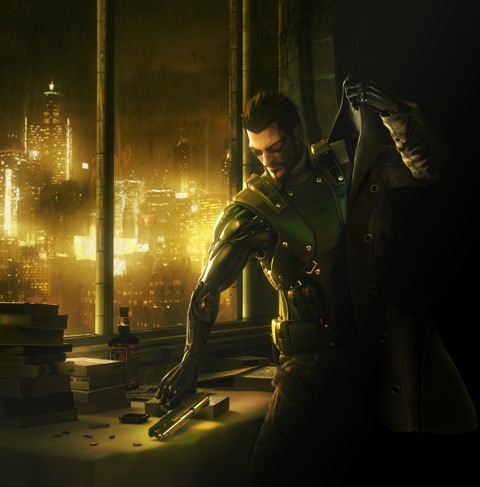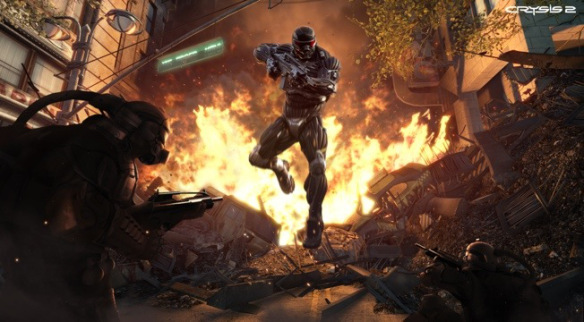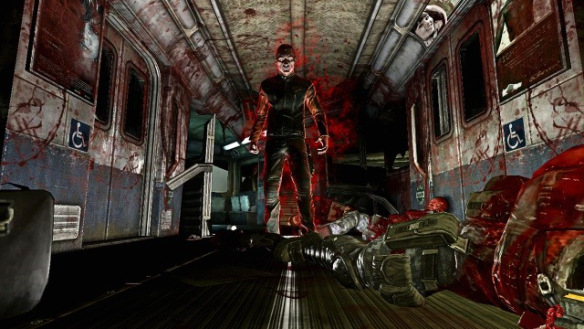A few weeks ago, I published my list of games I’ve played and beaten in 2011. From those, and only those, I’ve selected my top three of 2011.
I’m sure my personal game of the year will come as no surprise to anyone who has spoken/corresponded with at least a paragraph’s worth of dialogue to me in the past five months. I’ve already written the game to death in a blog series that I posted in September and October, so there really isn’t much more I can say. But I will try.
Game of the Year:
Deus Ex: Human Revolution

Deus Ex: Human Revolution launched on August 23, 2011. I beat it about two weeks after that. I’ve thought about Human Revolution every single day since then.
Even though I do think about the quests, the guns, the sneaking and the plot, I think about other facets of the game much more.
Human Revolution‘s art style, visual design and ideas about where medical technology is going in the future stick with me more than anything. At any given moment when I’m at home or at work, I sometimes wonder if human augmentations (in Human Revolution‘s scope) were real, how we could use them to aid us in tasks. It even spawned a discussion between me and a friend about what aug we could pick if given only one choice. Although I couldn’t decide on one, he wanted a pizza maker implanted in his body.
“There’s never enough pizza this time of night,” he joked.
Everything about Human Revolution wasn’t praise-worthy, however. It’s been said before that the boss battles were a mess and the endings were lackluster, but they didn’t drag the entire game down for it. Eidos Montréal even fixed the way boss battles worked in its excellent downloadable content episode The Missing Link. The development team knows Human Revolution‘s bosses didn’t fit with the game and remedied it in the DLC.
Here’s what they were supposed to be like, Eidos Montréal seemed to say.
In my lifetime of gaming, my eras have recently become divided by games that show me new ways to go about what I think games can be.
Last year Heavy Rain said, OK, let’s put the story before anything else and then tailor the game around it. Let’s make the action personal and cinematic. Let’s open things up to let the player interact with the world how he or she wants. And we’ll take away Game Over screens. The game doesn’t end until it ends. And it can end a plethora of ways.
This year, Deus Ex: Human Revolution said, OK, let’s make a game for gamers. Let’s pay heavy tribute to one of the greatest games of all time that this reboot is based on and make it accessible to this generation. And when Art Director Jonathan Jacques-Belletête stepped in he said, let’s make it beautiful and drown everything in the most consistent visual style a video game has had. Let’s take visual inspiration from things other than video games. Architecture, art, high fashion. It’s all There.
Thank the gaming gods for Jacques-Belletête.
I was live-streaming a session of Human Revolution to my friend Parker the other day. I was in Tai Young Medical’s upper office section, which is visually one of my favorite sections. I walked up to a desk.
“When I get a big-boy job, I want a desk like this in my office.” I said, crouching to inspect the polygonal drawers.
“That would be such an easy thing to overlook,” Parker said. At first I thought he meant for me to walk past and never notice it.
“No, I mean for a designer to overlook. Like, it’s just a desk. No one else would waste their time designing a desk.” He said.
Details like that are what set Human Revolution apart from any game I’ve played.
Honerable Mentions
Crysis 2

Crysis 2 launched early in 2011. Even though a fair amount of buzz swarmed around it, people seemed to forget it quickly.
I didn’t.
If I were forced to name a quality that gets me into games quickly, I’d say a predatory protagonist. Some of my favorite games (Hitman, Human Revolution, Splinter Cell) all possess this quality and Crysis 2 nails it.
Unlike games that ration out abilities, hand them to you in one level for you to conquer one goal and never use again, Crysis 2 gives you everything up front. Here you go, it says.Here are your guns, your invisibility, your super speed, your heavy armor, your slide and your high jump. Have a ball.
That, I did.
You see, Crysis 2 lets you be a predator, but it doesn’t stop there. If you want to equip your power armor, pull out the heavy machine gun and go guns blazing, you can do that, too. And if you want to sneak instead of stalk, you can move past numerous enemy encounters without touching a single person. The choice is yours.
The story might be dumb as shit and the characters and voice acting impossible to care for, but the game is fun.
It’s just fun. And beautiful.
Much like how Vanquish entertained me last year with its slick, fast and fun gameplay,Crysis 2 got me this year, but had me hooked for much longer. I ended up sellingVanquish, but I will never get rid of Crysis 2. It’s just too much fun, too beautiful and there are too many ways to play through scenarios in it.
It paces itself and lets you, for the most part, play at your pace. Deus Ex: Human Revolution did this, too and many games could learn from that pacing exercise. I don’t always (or ever) want to pay $60 to be beat over the head with waves of enemies for 8 hours and then watch the credits roll. Let me do things my way, and I promise I’ll stick around a lot longer.
F3AR
FEAR 3

I wouldn’t call myself a fanboy of the FEAR franchise, though I do like it. The story that’s strung over the games is pretty tangled, but it offers up slo-mo gunfights (a personal favorite), interesting weapons, reliable gunplay and sections of pure mindfuckery.
I also wouldn’t call the franchise very scary, despite it being titled FEAR. The first two games had their moments, but I was rarely scared. Then again, I prefer Silent Hill andCondemned-type horror that, instead of jumping at me, makes me terrified to step forward for what I might find.
When FEAR 3 came along, I was pleasantly surprised. It has a co-op hook, much likeResident Evil 5 (another not scary, scary game), but I played it by myself for my first time through. Although the third entry doesn’t really bring anything new to the table (other than co-op), I found that the developers, Day 1 Studios, (who ported the original FEAR to consoles) finally hit a sweet spot with the terror. Instead of shoehorning semi-terrifying moments in between intense gunfights, as the first two FEARs did, FEAR 3 has its own levels dedicated to horror.
Most notably is the Sam’s Club-esque bulk-item store you play through about a third into the campaign. Instead of armed soldiers popping out the whole time, an enemy doesn’t appear for a long stretch of the level.
This, ladies and gentlemen, is called pacing.
I spent at least fifteen minutes just wandering through the discount store until an enemy was even hinted to exist. After that, I could tell whatever monstrosity had taken over the store was funneling me into a trap, but I could do nothing but keep going. Just before the climax of the level, you’re placed in a huge, dark room and must navigate a maze of flatscreen TVs. On paper, it sounds lame, but it was extremely effective at cranking up the intensity. The TV screens flicker and change as you progress, some fall off their stands unexpectedly and, the whole time, you can hear the store’s demonic residents around you.
The entire level reminded me of the Condemned games, because it eschewed constant gunfighting for slower first-person horror and it stretched the pacing. There are a few levels in the campaign that do this and they’re some of the best for it.
It turns out that the co-op aspect of the game isn’t phoned in, either. The two characters, Point Man and Paxton Fettel have vastly different play styles. It’s nice to see a developer make a co-op mode that doesn’t consist of the main protagonist copied and pasted for the second character (such as in Resident Evil 5, Army of Two, Left 4 Dead, Halo, Rainbow Six… I could go on). Each character has his own unique abilities, which gives the otherwise linear campaign more replayability.
Point Man plays like an average FPS protagonist, with the exception of his slo-mo ability and some unique melee attacks, which include, but aren’t limited to the series’ staple jump kicks and slide kicks. Paxton Fettel, Point Man’s dead brother, (I said the story was tangled, right?) cannot hold firearms or slow down time, but he can possess enemies for short periods, explode their bodies from the inside out and shoot psychic blasts from his arms, among other things. It might not sound like there’s a world of difference between the two, but, in practice, there is. It’s especially fun to coordinate attacks if you’re playing co-op with a friend.
FEAR 3 also includes a Splinter Cell: Conviction-like in-game scoring system for certain moves. For example, you get points if you kill X amount of people with X attack, kill from cover X amount of times, possess X amount of enemies … you get the idea. At the conclusion of the game, it pits your score against your co-op partner’s, assuming you’ve played with the same partner the whole time. It’s a little gimmicky, but it got me to go back and play chapters again for different scores. Some achievements/trophies are also tied up in this system.

The original Crysis, Deus Ex and FEAR were all staple PC games when they launched in their respective generations. The franchises haven’t (yet) spawned yearly sequels and each have a ways to go before hitting an absolute sweet spot in their overall packages. However, they represent the most entertaining of games that I got my hands on in 2011.
VentureBeat's mission is to be a digital town square for technical decision-makers to gain knowledge about transformative enterprise technology and transact. Learn More
